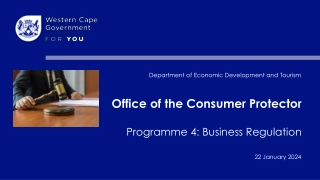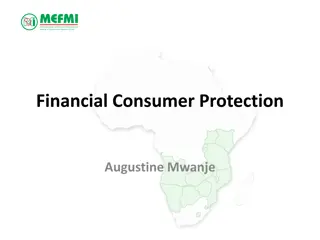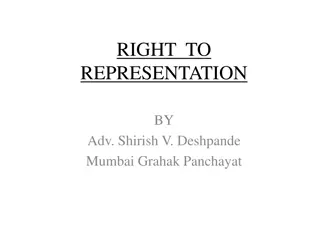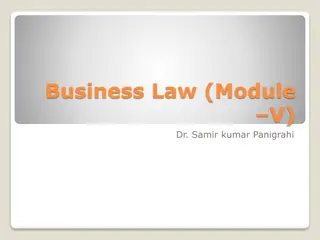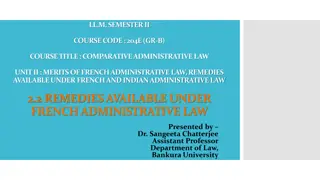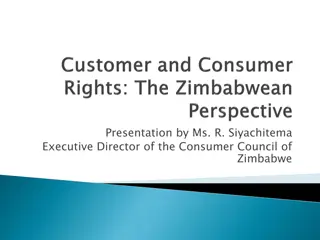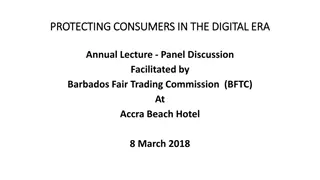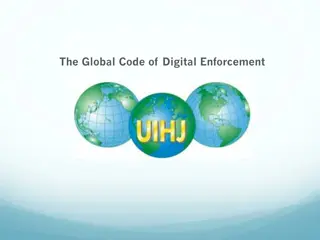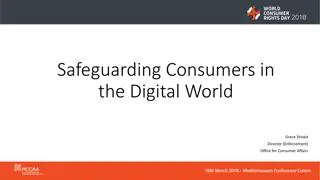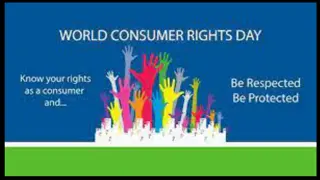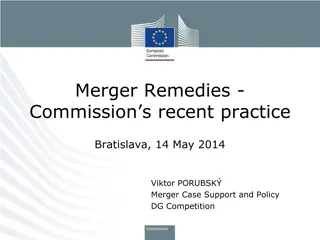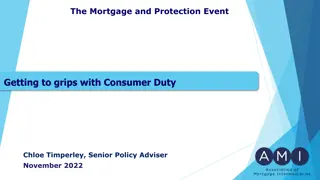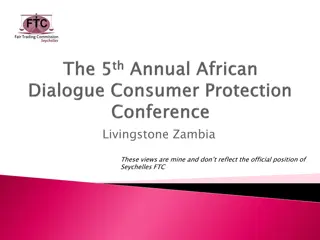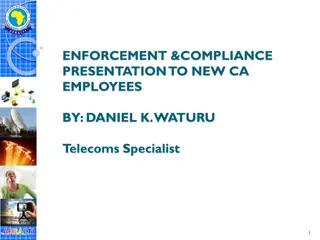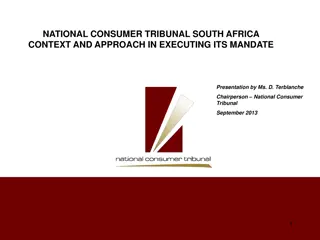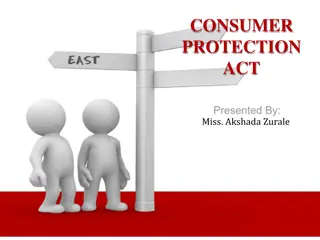Understanding Consumer Protection Remedies and Enforcement Mechanisms
Explore the key aspects of consumer protection remedies and enforcement mechanisms, including their purposes, types, effectiveness, and application against wrongdoers like fraudsters. Learn about injunctive relief, monetary remedies, compliance monitoring, and more to ensure consumer rights are safeguarded in the marketplace.
Download Presentation

Please find below an Image/Link to download the presentation.
The content on the website is provided AS IS for your information and personal use only. It may not be sold, licensed, or shared on other websites without obtaining consent from the author. Download presentation by click this link. If you encounter any issues during the download, it is possible that the publisher has removed the file from their server.
E N D
Presentation Transcript
Fifth Annual African Consumer Protection Dialogue Fifth Annual African Consumer Protection Dialogue Livingstone, Zambia 12 September 2013 Livingstone, Zambia
Purposes of Remedies Stop, correct, prevent Punish Types of Remedies Injunctions, information, money, reputation, education Effectiveness of a Remedy 2
Remedies against wrongdoers (fraudsters) Incapacitation Stop this fraud now Specific Deterrence Stop this fraudster later General Deterrence Stop other fraudsters Remedies to help victims Usually, attempts to restore the past Sometimes, goes further and rewards, e.g., a whistleblower Education Generally applicable, not specific to fraudster or victim 3
Analyzing Remedy Options Injunctive Relief mostly stops the fraudster Informational Remedies some of both Monetary Relief mostly helps the victim Reputational Remedies some of both Remember the purpose of the remedy to evaluate its effectiveness. Any one remedy may serve multiple purposes. 4
Civil 1. TRO/Receivership 2. Preliminary Injunction <trial or settlement> 3. Permanent Injunction 4. Compliance Monitoring 5. Contempt Proceeding NOW: Criminal 1. Arrest or Indictment 2. Pretrial release <trial or plea> 3. Sentencing LATER: 4. Probation 5. 2nd Prosecution 5
Enjoining the exact same conduct that was challenged Adding fencing in relief Raising standards Higher levels of substantiation Pre-approval of claims, such as drug claims Bonds and bans for otherwise lawful conduct Positive Injunctions Destruction of fraudulent products Disposal of customer lists 6
Compliance Monitoring enforce the order: Compliance Reporting costs Report periodically on current location and activities Send notice of key developments, such as change of address Supply additional information upon request Record evidence Confirmation denial of knowledge Distribution of order to employees and affiliates Acknowledge receipt of order by defendants and others Compliance Monitoring provisions make it easier to Compliance Reporting: reduces investigative Record- -keeping Requirements keeping Requirements: preserves Confirmation: promotes deterrence, precludes 7
Notice of suit or settlement Ex. Letter to customers or distributors Ex. Media coverage resulting from press release on ftc.gov Admission Ex. Fraudster s admission of liability in settlement Pronouncement Ex. Finding of liability by tribunal court s ruling and opinion Cease and desist Ex. Administrative order halts dissemination of the deception 8
Injunctive order Ex. order stops dissemination of the deception Trade name excision Ex. Forbid use of brand name when it is unavoidably deceptive, or perhaps when it is imbued with goodwill Mandated disclosures Ex. Affirmative disclosures such as warning labels Corrective advertising Ex. Company required to sponsor an ad campaign to reverse a deceptive impression Consumer education Ex. Company distributes government materials Ex. Company funds campaign by government or NGO, such as a trade association or charity 9
Restitution Disgorgement Damages Fines and Penalties 10
For injunctive relief and informational remedies, the main issue is the fit between the remedy and the wrong Monetary relief raises more questions: How much money? Who pays it? Who receives it? When? How? And, other more advanced questions. 11
Calculated as: Profits plus Revenue (sales less refunds) -> restitution Injury caused Legal basis: -> disgorgement -> damages trebled exemplary Fine -> civil or criminal 12
Set by law Fixed or by formula Factors may be variable Justice requires: deterrence punishment based on culpability Recompense of non-consumer injury: harm was to markets or public repay costs to society Many other factors possible 13
When used? Temporary relief: Ex. Asset Freeze preserves funds Final relief: Ex. Judgment amount due now How collected? Rescission of contract forbid fraudster collecting on consumers alleged debts Order turnover or disposal of a specific asset Judgment Collections action, such as garnishment Seizure of funds or assets by government Who gets the money? Refunded directly to consumers Paid to government on behalf of consumers generally Paid to government for return to specific consumers (redress program) 14
Does the fraudster owe for actions of others in the fraud? Ex. Joint and several liability, common enterprise theory Can funds be recovered from non-fraudsters? Ex. Relief defendant, constructive trust Does the court raise the burden of proof? Ex. Tracing requirement What if fraudster owes more than it has? Ex. Inability to pay reduces amount owed, unpaid amount becomes collectible in future How do we resolve uncertainty over ability to pay? Ex. Shift burden to wrongdoer through financial attestation Backed by avalanche clause Criminal prosecution 15
Reputation Corporate ethics Voluntary association standards NGO publicity Government censure Reputation Effectiveness Fraud vs. legitimate Impact of censure on company 16
Cost of the remedy > fraudsters gain from continuing? Illegal gain includes: Fraudster s profits Avoided expenses of compliance Cost of remedy may be other than monetary relief: Reputational interests Loss of company s value in stock market Consider: Probability of detection/prosecution Rationality of actor General deterrence may require even greater publicity to be perceived A remedy that does not deter is a cost of doing business Cost of the remedy > fraudster s gain from continuing? cost of doing business 17
Evaluate the remedy against its purpose(s) A small redress check helps the consumer victim somewhat but does not deter the fraudster. A large fine might deter but does not redress. A large bond: 1. helps deter the fraudster, but 2. also provide a pool of funds for redress if needed. Evaluate the remedies against each other A (telemarketing) ban helps deter the fraudster next time and its violation tends to be easier to prove than a violation of injunctive relief (against misrepresentations). Evaluate the effectiveness of the remedy over time Compliance monitoring Evaluate the remedy against its purpose(s) Evaluate the remedies against each other Evaluate the effectiveness of the remedy over time 18



